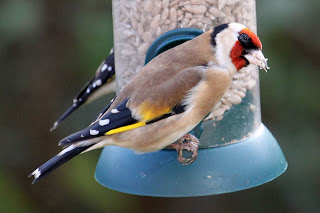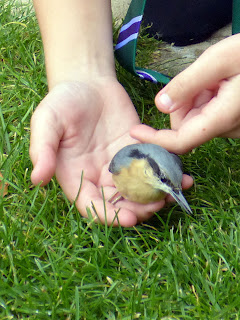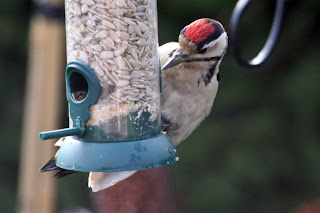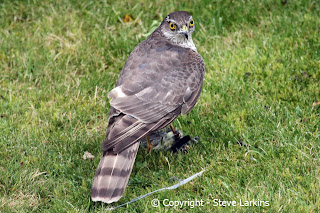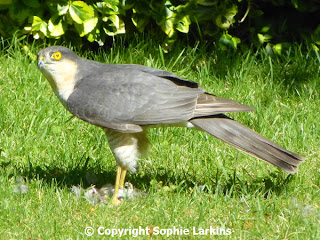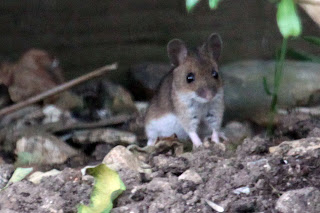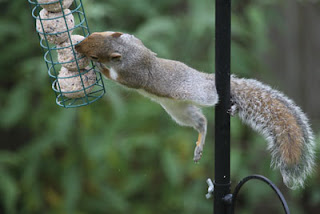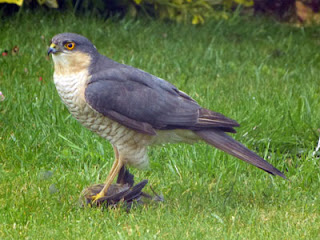The onset of a particularly cold snap this week has brought in a few new garden bird visitors as food is becoming harder to find elsewhere. This Pied Wagtail was busy clearing up the crumbs dropped by other birds feeding on the Suet Balls. Pied Wagtails are one of my favourite birds - bold and full of character.
It's more difficult to get good pictures in the dull light of winter - this shot was taken with the Canon 100-400mm lens wide open at F5.6 and the camera set to ISO800, which results in a grainier image.
Thursday, 6 December 2012
Saturday, 24 November 2012
Foraging Jays
Jays are incredibly busy this time of the year burying acorns and foraging for food. They often fly around in small groups and this bird was part of a pair which was seen close to our house digging up acorns from the lawn opposite.
Jays are clever, resourceful birds and will often visit a bird table, particularly for peanuts which they then stash for the harder times of winter. They have a darker side though as, in Spring, part of their diet includes young fledgling birds.
Jays are clever, resourceful birds and will often visit a bird table, particularly for peanuts which they then stash for the harder times of winter. They have a darker side though as, in Spring, part of their diet includes young fledgling birds.
Sunday, 18 November 2012
Window Feeder Experiment
We were interested to see which birds would feed from a Sunflower Feeder mounted right next to our kitchen window.
For the experiment the window feeder was positioned just 10cm from the glass, so we were sure that many birds would be put off by the proximity of the house and us humans walking around inside peering at them!
To our amazement, a whole variety of birds visit the feeder, some even feed when we stand still right next to the window! So far we've had a Nuthatch (pictured), lots of Blue Tits, Great Tits, Coal Tits, a Marsh Tit and a Robin visit.
It is interesting that sparrows are not on the list of visitors, so the sunflower hearts tend to last that bit longer now!
For the experiment the window feeder was positioned just 10cm from the glass, so we were sure that many birds would be put off by the proximity of the house and us humans walking around inside peering at them!
To our amazement, a whole variety of birds visit the feeder, some even feed when we stand still right next to the window! So far we've had a Nuthatch (pictured), lots of Blue Tits, Great Tits, Coal Tits, a Marsh Tit and a Robin visit.
It is interesting that sparrows are not on the list of visitors, so the sunflower hearts tend to last that bit longer now!
Saturday, 17 November 2012
Migrating Goldfinches
The autumn season seems to be the best time of the year to see Goldfinches, as some birds head down to Spain to escape the cold winter weather of northern Europe.
This time of the year, quite large groups of migrating Goldfinches (sometimes twenty or more) congregate on Greenham Common feeding off seed-heads and we are lucky enough to get quite a few on our Nyjer and Sunflower feeders.
The Goldfinch has to be one of the UK's most striking garden birds and this picture - taken this morning shows the stunning red face and yellow wing stripe plumage of these birds.
This time of the year, quite large groups of migrating Goldfinches (sometimes twenty or more) congregate on Greenham Common feeding off seed-heads and we are lucky enough to get quite a few on our Nyjer and Sunflower feeders.
The Goldfinch has to be one of the UK's most striking garden birds and this picture - taken this morning shows the stunning red face and yellow wing stripe plumage of these birds.
Wednesday, 31 October 2012
Ringed Greenfinch
Oddly, even the Goldfinches prefer Sunflower Hearts to their other favourite staple food - Nyjer seed. The moral of the story is to buy yourself a big bag of Sunflower Hearts and stay clear of the Nyjer. You'll keep your lawn free of Nyjer seedlings at the same time!
Saturday, 13 October 2012
Sparrowhawk Kills Blue Tit
Seeing a Sparrowhawk kill makes you realise just how fast these birds are! One unfortunate Blue Tit had its last meal from our Sunflower Feeder today when it failed to spot a Male Sparrowhawk sat on the fence. The Sparrowhawk launched instantly and caught the Blue Tit in mid air with an impressive display of acrobatics - fanning and feathering its tail to get in just the right position to make a grab of the victim with its talons. It was a rapid end-of-life for one of this year's Blue Tits.
Saturday, 29 September 2012
Male Bullfinch Sighting
The return of the Male Bullfinch, absent through most of the summer from our garden is a welcome sight. It has been spotted twice today, once early in the morning and again late in the afternoon. Bullfinches are notoriously shy and elusive and will fly off at the slightest disturbance, so we were only able to get a picture through the glass of the upstairs window - so the image quality is a little compromised. Within 5 minutes the Marsh Tit had arrived on the seed tray too! Two rare garden birds within 10 minutes; we can't complain!
Saturday, 22 September 2012
Lone Wheatear on Greenham Common
Marsh Tit in our Greenham Garden!
The last Marsh Tit sighting in our garden was in June 2011, until yesterday when one quite unexpectedly started visiting our seed tray.
Spotting the difference between a Marsh Tit and a Willow Tit is difficult, but Marsh Tits tend to be much more regular bird table visitors, so we are pretty sure this bird is a Marsh Tit.
It was once again spotted taking sunflower hearts this afternoon, then flew off in the general direction of Greenham Common so it may be resident in the woodland there. We got this good picture.
Spotting the difference between a Marsh Tit and a Willow Tit is difficult, but Marsh Tits tend to be much more regular bird table visitors, so we are pretty sure this bird is a Marsh Tit.
It was once again spotted taking sunflower hearts this afternoon, then flew off in the general direction of Greenham Common so it may be resident in the woodland there. We got this good picture.
Thursday, 20 September 2012
Nuthatch Needs Helping Hand
I was shocked and surprised to see a Nuthatch lying motionless below our garage door on the path this afternoon. Turns out it had flown into the window and stunned itself.
I carefully picked it up and placed it on the lawn next to some sunflower hearts and to our relief it recovered after about fifteen minutes and flew off. We hope it returns to our feeder soon to confirm that it survived its ordeal as it was obviously very frightened. Sophie got to hold the little chap and can confirm that Nuthatches have very sharp claws!
Sadly, we think this bird died a couple of weeks after it was injured. Our previous pair of Nuthatches is now just one solitary bird.
I carefully picked it up and placed it on the lawn next to some sunflower hearts and to our relief it recovered after about fifteen minutes and flew off. We hope it returns to our feeder soon to confirm that it survived its ordeal as it was obviously very frightened. Sophie got to hold the little chap and can confirm that Nuthatches have very sharp claws!
Sadly, we think this bird died a couple of weeks after it was injured. Our previous pair of Nuthatches is now just one solitary bird.
Tuesday, 18 September 2012
Wheatear Sighting
Sightings of Wheatear on heathland in the south of England are an indication that autumn has well and truly arrived.
This morning a pair of these beautiful birds were seen along the disused central runway section of Greenham Common about one mile east of the Pyle Hill entrance. They are unmistakable in flight as you'll see the large white square just above their dark tail when in flight. Wheatears are a sandy brown colour in autumn, having lost their grey back. Size-wise, they are slightly smaller than blackbirds and they are quite bold allowing you to get reasonably close in order to take photographs.
This morning a pair of these beautiful birds were seen along the disused central runway section of Greenham Common about one mile east of the Pyle Hill entrance. They are unmistakable in flight as you'll see the large white square just above their dark tail when in flight. Wheatears are a sandy brown colour in autumn, having lost their grey back. Size-wise, they are slightly smaller than blackbirds and they are quite bold allowing you to get reasonably close in order to take photographs.
Sunday, 16 September 2012
Woodlark Sighting
My recent trip onto Greenham Common in search of migrating Wheatears proved fruitless, but I did spot a pair of Woodlarks close to the Bishops Green entrance sitting on the ground.
These birds are very well camouflaged and hard to spot until they fly away when you get too close. Some perseverance produced this reasonable picture.
To find the Woodlark sighting spot, enter Greenham Common from the eastern most gated entrance at Bishops Green and follow the narrow footpath off to the left down the hill and then round to the right where an open area adjoins woodland. This seems to be a 'hotspot' for Woodlark and Green Woodpeckers.
These birds are very well camouflaged and hard to spot until they fly away when you get too close. Some perseverance produced this reasonable picture.
To find the Woodlark sighting spot, enter Greenham Common from the eastern most gated entrance at Bishops Green and follow the narrow footpath off to the left down the hill and then round to the right where an open area adjoins woodland. This seems to be a 'hotspot' for Woodlark and Green Woodpeckers.
Monday, 20 August 2012
Red Kite Hunting
Grass cutting in the field adjacent to West Wood, Newbury this afternoon attracted two Red Kites who were hunting for wood mice and rabbits. One of the birds landed at one point.
Red Kites have even been known to take children's cuddly toys from gardens in this area, after confusing them for small mammals!
Friday, 17 August 2012
Coal Tit Returns
A Coal Tit is significantly smaller than a great tit and with subtly different colours. There is a white middle part to the back of a Coal Tit's head and it's breast is a soft chestnut colour.
I caught this one feeding from our Sunflower Hearts feeder, but he is also partial to our Fat Balls.
I caught this one feeding from our Sunflower Hearts feeder, but he is also partial to our Fat Balls.
Green Woodpecker Close Encounter
The large numbers of ants in our lawn have attracted quite a few Green Woodpeckers in the last few weeks, but there was a close encounter this week when one of the birds came right close to the window, so close in fact I was amazed it didn't freak out when it saw me, as Green Woodpeckers are notoriously shy and will make a hasty retreat when anything or anybody disturbs them.
Click this picture to see the detail in it!
Click this picture to see the detail in it!
Thursday, 9 August 2012
Attracting Rare Birds to your Garden
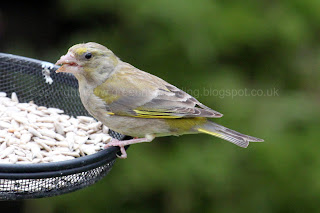 Whether or not you can attract rare or uncommon birds to your garden comes down to the proximity of nearby woodland and open space and the type of food you put out. Here in Greenham we have around a 1000 acres of open space and woodland at Greenham Common and nearby West Wood, so we're spoilt!
Whether or not you can attract rare or uncommon birds to your garden comes down to the proximity of nearby woodland and open space and the type of food you put out. Here in Greenham we have around a 1000 acres of open space and woodland at Greenham Common and nearby West Wood, so we're spoilt!It has become really apparent over many months of experimentation that the best combinations of food for attracting some of the rarer garden birds are:
- Suet balls (aka fat balls) for Great Spotted Woodpecker
- Sunflower hearts for Nuthatch, Bullfinch and Greenfinch as well as Blue Tit and Great Tit
- Nyjer for Goldfinch, Bullfinch (surprisingly) and Greenfinch
- Peanuts for Great Spotted Woodpecker, and Nuthatch + Great Tit, Blue Tit
Monday, 6 August 2012
Great Spotted Woodpecker
The better lighting conditions of the summer have allowed us to take some amazing pictures of the Great Spotted Woodpeckers which frequent our garden from nearby Greenham Common and West Wood, south east of Newbury.
As well as the male pictured (right) there are two juveniles which fight if they arrive at the same time!
The lower of the three pictures is the juvenile which is nearly the size of the adult, but is distinguishable by its red cap and more freckly back parts.
The adult Great Spotted Woodpecker will also defend its territory from the juveniles, even though we suspect that they are its own young. Presumably it thinks they should fend for themselves now and move to a different territory and find their own food!
Top two pictures - taken with Canon EOS500D SLR, ISO400, Canon EF 100-400mm Zoom lens at F6.3 and F7.1, 1/500 second exposure.
Bottom picture - taken with Canon EOS500D SLR, ISO800, Canon EF 100-400 lens at F6.3 1/320 second exposure.
As well as the male pictured (right) there are two juveniles which fight if they arrive at the same time!
The lower of the three pictures is the juvenile which is nearly the size of the adult, but is distinguishable by its red cap and more freckly back parts.
The adult Great Spotted Woodpecker will also defend its territory from the juveniles, even though we suspect that they are its own young. Presumably it thinks they should fend for themselves now and move to a different territory and find their own food!
Top two pictures - taken with Canon EOS500D SLR, ISO400, Canon EF 100-400mm Zoom lens at F6.3 and F7.1, 1/500 second exposure.
Bottom picture - taken with Canon EOS500D SLR, ISO800, Canon EF 100-400 lens at F6.3 1/320 second exposure.
Juvenile Bullfinches
Whilst we've not seen the pair of bullfinches recently, these two juveniles turned up on our seed tray the other morning.
These birds are still to acquire the beautiful plumage of the adults, and OK they look a little drab in comparison, not helped by having soaked feathers as it had just been a heavy shower.
Bullfinches have become increasingly rare over the last few years due to persecution, following their unfortunate habit of stripping the buds off fruit trees in the Spring. We have witnessed this destructive behaviour on a mature apple tree opposite our house in February each year.
Ironically the picture (right) shows the young Bullfinch sat on our Apple Tree, presumably eyeing it up for next Spring's bud-feast!
These birds are still to acquire the beautiful plumage of the adults, and OK they look a little drab in comparison, not helped by having soaked feathers as it had just been a heavy shower.
Bullfinches have become increasingly rare over the last few years due to persecution, following their unfortunate habit of stripping the buds off fruit trees in the Spring. We have witnessed this destructive behaviour on a mature apple tree opposite our house in February each year.
Ironically the picture (right) shows the young Bullfinch sat on our Apple Tree, presumably eyeing it up for next Spring's bud-feast!
Characterful Jays
There's no doubt that Jays are not only one of the most stunning garden birds, they are also full of character and are highly amusing to watch as they cunningly plan their next move.
This one has already started preparing for winter by finding places to stash peanuts from our seed tray. Over a few days he has got more daring and even sit right next to the house window peering in!
There are little holes in the ground where the nuts are placed. Question is - will it remember where they are when food is more scarce over the winter months?
For any budding photographers, these stunning photographs were taken on our budget Canon EOS500D SLR camera at ISO800 with the Canon 100-400mm EF IS lens at F7.1, 1/1000sec exposure. The lens cost twice as much as the camera, but this shows that lens quality makes all the difference!
This one has already started preparing for winter by finding places to stash peanuts from our seed tray. Over a few days he has got more daring and even sit right next to the house window peering in!
There are little holes in the ground where the nuts are placed. Question is - will it remember where they are when food is more scarce over the winter months?
For any budding photographers, these stunning photographs were taken on our budget Canon EOS500D SLR camera at ISO800 with the Canon 100-400mm EF IS lens at F7.1, 1/1000sec exposure. The lens cost twice as much as the camera, but this shows that lens quality makes all the difference!
Wednesday, 1 August 2012
Bad Feather Day
It is always interesting to see the reduction in food taken during days when the Sparrowhawk visits!
Also goes to show that birds or prey can have the equivalent of a bad hair day - let's call it a 'bad feather day'!
Tuesday, 31 July 2012
Long Billed Dowitcher
The Long Billed Dowitcher is a very rare sighting in the UK, with only a handful of them being spotted per year on average - usually in the Autumn or Winter season. This bird was spotted on South Lake at the Slimbridge Wetland Reserve in Gloucestershire on Monday 30th July 2012.
Long Billed Dowitchers breed in the far north of North America and in eastern Siberia, so spotting one in the UK during the breeding season may be indicative of the odd weather we've had this summer with the jet stream being further south.
Unfortunately the Dowitcher was a fair distance away and the sun was reluctant to show itself, so the pictures are a little compromised. The bird was amongst lots of Black Tailed Godwits which made spotting it difficult without expert help from more experienced twitchers. These pictures were taken with the Canon 100-400mm lens at F8.
Long Billed Dowitchers breed in the far north of North America and in eastern Siberia, so spotting one in the UK during the breeding season may be indicative of the odd weather we've had this summer with the jet stream being further south.
Unfortunately the Dowitcher was a fair distance away and the sun was reluctant to show itself, so the pictures are a little compromised. The bird was amongst lots of Black Tailed Godwits which made spotting it difficult without expert help from more experienced twitchers. These pictures were taken with the Canon 100-400mm lens at F8.
Tuesday, 10 July 2012
Fledgling Green Woodpeckers
Over the last week, we have noticed how the bird activity has dropped immensely at the feeding station because the birds are able to find more natural food. Today though, we found something to write about.
We looked out the window this morning and saw three juvenile woodpeckers and one adult male feasting on ant nests on the other side of our residential road. Juveniles are recognisable by their speckled plumage and males have red "moustaches" and females have black ones. Here's an up-close video of a juvenile Green Woodpecker. Enjoy!
We looked out the window this morning and saw three juvenile woodpeckers and one adult male feasting on ant nests on the other side of our residential road. Juveniles are recognisable by their speckled plumage and males have red "moustaches" and females have black ones. Here's an up-close video of a juvenile Green Woodpecker. Enjoy!
Monday, 9 July 2012
Sparrowhawk kills Blue Tit
It seems that our Greenham garden is now being frequented by the Juvenile Sparrowhawk and its hunting skills are improving. It's mid-morning snack was one of our fledgling Blue Tits. We were only counting them yesterday and commented on there being seven of them. Now there are only six!
The Sparrowhawk is an ambush predator and small birds make up most of the male and juvenile Sparrowhawk's diet. The female, being larger can take much larger birds including Wood Pigeons.
The bird's presence in our garden has freaked out the birds who now make very short visits to the bird feeders before retiring to nearby bushes! It's a beautiful bird though we think it's the same ringed bird that we had a week ago.
This stunning picture expands to 1000x667 pixels when clicked and was taken through a double glazed window at F5.6 1/500s at 400mm on the Canon 100-400mm EF IS lens and Canon 500D body.
The Sparrowhawk is an ambush predator and small birds make up most of the male and juvenile Sparrowhawk's diet. The female, being larger can take much larger birds including Wood Pigeons.
The bird's presence in our garden has freaked out the birds who now make very short visits to the bird feeders before retiring to nearby bushes! It's a beautiful bird though we think it's the same ringed bird that we had a week ago.
This stunning picture expands to 1000x667 pixels when clicked and was taken through a double glazed window at F5.6 1/500s at 400mm on the Canon 100-400mm EF IS lens and Canon 500D body.
Monday, 2 July 2012
Juvenile Sparrowhawk Tries Hunting
A juvenile Sparrowhawk arrived at lunchtime today and sat on the fence at the bottom of our garden for an incredible 35 minutes, just observing the birds on the various feeders. We took an HD Video of this.
Amazingly Blue Tits were feasting on the peanut feeder only 12 feet away, but the 'Sprawk' just sat there eyes affixed staring not seeming to know what to do. Eventually a rather poor attempt at grabbing a Blue Tit was made, but it was just too fast for the Sparrowhawk and escaped into the bushes. The Sparrowhawk quickly conceded defeat and flew off towards Greenham Common. It seems that it needs a lesson in effective hunting from its Dad who has been much more successful in recent visits.
Interestingly, a video I took shows this as a ringed bird.
Amazingly Blue Tits were feasting on the peanut feeder only 12 feet away, but the 'Sprawk' just sat there eyes affixed staring not seeming to know what to do. Eventually a rather poor attempt at grabbing a Blue Tit was made, but it was just too fast for the Sparrowhawk and escaped into the bushes. The Sparrowhawk quickly conceded defeat and flew off towards Greenham Common. It seems that it needs a lesson in effective hunting from its Dad who has been much more successful in recent visits.
Interestingly, a video I took shows this as a ringed bird.
Sunday, 1 July 2012
Green Woodpecker Video
Green Woodpeckers are very shy birds and any attempt to approach them usually results in a swift departure. They are significantly bigger than a Great Spotted Woodpecker and spend a lot of their time on the ground feeding on insects, with a particular fondness for small ant nests in grass.
We were very lucky to take this HD video of a male Green Woodpecker feeding on ants at the edge of our front lawn in Greenham a few days ago. It has been back several times, but flies off when cars come down the road, so we have to be quick with the camera!
We were very lucky to take this HD video of a male Green Woodpecker feeding on ants at the edge of our front lawn in Greenham a few days ago. It has been back several times, but flies off when cars come down the road, so we have to be quick with the camera!
Saturday, 30 June 2012
Baby Blackbird enjoys the sun!
We saw this young Blackbird lying on our patio today like it was dead and wondered what on earth it was doing. Recently we have had a lot of baby birds and most of them look to be lying around being lazy all day and being fed by their parents but we think that these birds are sunning themselves (we don't blame them!)
Thursday, 28 June 2012
Sparrowhawk Returns
This afternoon was not a very good afternoon for one of our resident sparrows. We were hoping that the Sparrowhawk wouldn't predate any more birds in our garden but sadly today we saw the Sparrowhawk sat on the ground, its bold yellow eyes peering up at us with an unfortunate House Sparrow in its talons.
Sparrowhawks feed on an amazing variety of prey including: small birds (as tiny as a Goldcrest), pigeons and doves, birds as big as Pheasants, small mammals like mice and voles and, in some cases, bats!
Sparrowhawks feed on an amazing variety of prey including: small birds (as tiny as a Goldcrest), pigeons and doves, birds as big as Pheasants, small mammals like mice and voles and, in some cases, bats!
Although Sparrowhawks kill a lot of prey, they are actually hunted themselves by Goshawks who do not tolerate the smaller birds in their territory and younger birds are often taken by Tawny Owls. Female Sparrowhawks generally take larger prey because they are 25% bigger than the males and she will sometimes kill her mate! Males can live to up to seven or eight years and females can live up to eleven years of age!
Saturday, 23 June 2012
Green Woodpecker Sighting
Just as we thought there was going to be no more bird activity tonight, a Green Woodpecker arrived on our front lawn frantically pecking up ants (and the edges of the lawn).
Green Woodpeckers are very shy birds and he flew off several times when cars approached, returning a few minutes later to continue the feast! We got some great pictures. This picture was taken with the Canon EF 100-400mm IS Telephoto lens at just 1/60 second (using ISO800 and F5.6) which shows what can be achieved with this lens hand-held.
Amazingly, he was on the grass opposite at one point with a pair of Bullfinches (male and female).
Green Woodpeckers are very shy birds and he flew off several times when cars approached, returning a few minutes later to continue the feast! We got some great pictures. This picture was taken with the Canon EF 100-400mm IS Telephoto lens at just 1/60 second (using ISO800 and F5.6) which shows what can be achieved with this lens hand-held.
Amazingly, he was on the grass opposite at one point with a pair of Bullfinches (male and female).
Fledgling Woodpecker Has Tea!
At 6pm we saw our Fledgling Great Spotted Woodpecker getting fed by the adult male bird.
The youngster is actually pretty independent now and needs little help, so it shows that adult woodpeckers are pretty good parents. The fledgling still follows the adult Woodpecker around and we frequently see him on our feeders. The Suet Balls or Peanut Feeder seem to be favoured by both birds.
The youngster is actually pretty independent now and needs little help, so it shows that adult woodpeckers are pretty good parents. The fledgling still follows the adult Woodpecker around and we frequently see him on our feeders. The Suet Balls or Peanut Feeder seem to be favoured by both birds.
Shy Stock Dove
We have recently seen a Stock Dove in our garden but we had to read a lot of bird books before we were completely sure that it was a Stock Dove! These little pigeons are incredibly shy and secretive and it is very hard to get a decent picture through the window.
We managed to get a photo by slowly opening the window and sliding the Canon long lens out and hoping it didn't fly off! You can tell the difference between a Stock dove and a Woodpigeon by the white on the neck (Stock Doves lack this) and the size of the bird. Stock doves have large black eyes and Woodpigeons have yellow eyes with a black pupil.
We managed to get a photo by slowly opening the window and sliding the Canon long lens out and hoping it didn't fly off! You can tell the difference between a Stock dove and a Woodpigeon by the white on the neck (Stock Doves lack this) and the size of the bird. Stock doves have large black eyes and Woodpigeons have yellow eyes with a black pupil.
Jay Visits Bird Feeder
This morning we were doing the usual "bird checks" after all the nuts were gone on the seed tray a couple of days ago and we were curious to find out what this hungry being was that was nicking the food.
Today in the garden and we were lucky enough to see that it was actually a clever Jay that was sat on the tray and didn't seem remotely bothered that we were peering out of the window.
It's a bit early to be storing nuts for winter mate!
Today in the garden and we were lucky enough to see that it was actually a clever Jay that was sat on the tray and didn't seem remotely bothered that we were peering out of the window.
It's a bit early to be storing nuts for winter mate!
Wednesday, 20 June 2012
Baby Nuthatch Grows Up Fast!
Before
 This afternoon we had a reunion with one of our best-loved garden birds. This particular Nuthatch we think came from the Nuthatch nest in a tree hole close to the Pyle Hill entrance on Greenham Common and was a very young individual the first time we saw him. Meet "Scraggle", our baby Nuthatch, although he doesn't quite live up to his name any more.
This afternoon we had a reunion with one of our best-loved garden birds. This particular Nuthatch we think came from the Nuthatch nest in a tree hole close to the Pyle Hill entrance on Greenham Common and was a very young individual the first time we saw him. Meet "Scraggle", our baby Nuthatch, although he doesn't quite live up to his name any more.We have recently put up a new peanut feeder up and much to our surprise the Woodpecker and Nuthatch have both used it within days of putting it up.
After
 These 'before' and 'after' pictures show how "Scraggle" has changed and has become more like a fully fledged adult in just a few weeks!
These 'before' and 'after' pictures show how "Scraggle" has changed and has become more like a fully fledged adult in just a few weeks!He is now more than capable of adopting the classic upside-down Nuthatch stance, this time with his head raised looking for danger.
Juvenile Great Spotted Woodpecker
We were delighted when the Great Spotted Woodpecker which is frequent visitor to the Suet Ball Feeder in our garden decided to bring along its baby this afternoon. Juvenile woodpeckers have a larger red portion on their head.
We got some good pictures and the baby Woodpecker was seen being fed by the adult and later feeding itself on the peanut feeder. This evening it spent 10 minutes on the same feeder by itself, no adult in sight, so it has really gained its independence.
This Great Spotted Woodpecker video was taken out of our bedroom window on our Suet Ball Feder. Enjoy!
We got some good pictures and the baby Woodpecker was seen being fed by the adult and later feeding itself on the peanut feeder. This evening it spent 10 minutes on the same feeder by itself, no adult in sight, so it has really gained its independence.
This Great Spotted Woodpecker video was taken out of our bedroom window on our Suet Ball Feder. Enjoy!
Friday, 15 June 2012
Wood Mouse and Squirrel
It's not just the birds which take advantage of the plentiful food on offer in our garden.
We now have a rather cute Wood Mouse and a less cute Grey Squirrel who raids all the food and even ate part of the plastic feeder in his efforts to release more of the Sunflower Mix.
The Grey Squirrel doesn't take 'no' for an answer and will stand his ground even when we get close to him to move him off the food!
The Squirrel's acrobatics are amazing. He is capable of death-defying feats to reach impossibly high feeders with ease!
His more destructive antics include chewing through the plastic on the feeders to release more Sunflower Hearts.
We now have a rather cute Wood Mouse and a less cute Grey Squirrel who raids all the food and even ate part of the plastic feeder in his efforts to release more of the Sunflower Mix.
The Grey Squirrel doesn't take 'no' for an answer and will stand his ground even when we get close to him to move him off the food!
The Squirrel's acrobatics are amazing. He is capable of death-defying feats to reach impossibly high feeders with ease!
His more destructive antics include chewing through the plastic on the feeders to release more Sunflower Hearts.
Summer Finches
We have recently put up a Nyjer feeder and much to our surprise it's not just Goldfinches that like it. We get regular visits from a pair of stunning Bullfinches who seem to be just as keen on Nyjer as the Goldfinches. Greenfinches will eat it too.
Today we topped the most Goldfinches we've ever seen in the garden. We saw 7 at the same time, with some feeding on the Sunflower Heart Mix which seems to be popular with pretty much all our birds. Expensive to buy though - at £35 for 12.5Kg!
There's no doubt that Goldfinches are stunning looking birds and one of ours seems to have a ring on its leg, so it must have been ringed at some time then released. Our Goldfinches spend hours on the Nyjer feeder - sometimes arriving shortly after daybreak.
Today we topped the most Goldfinches we've ever seen in the garden. We saw 7 at the same time, with some feeding on the Sunflower Heart Mix which seems to be popular with pretty much all our birds. Expensive to buy though - at £35 for 12.5Kg!
There's no doubt that Goldfinches are stunning looking birds and one of ours seems to have a ring on its leg, so it must have been ringed at some time then released. Our Goldfinches spend hours on the Nyjer feeder - sometimes arriving shortly after daybreak.
Sparrowhawk Kill
This morning we woke up at around 6am and were watching the baby birds from our lounge window. Regular visitors include baby Blue Tits and Great Tits, baby Starlings two young Blackbirds and a juvenile Robin.
Recently we've been getting a juvenile Bullfinch and Dunnock. Unfortunately the baby Dunnock met with an untimely end this morning when it was sadly taken by a male Sparrowhawk.
This aggressive predator had obviously been eyeing up our fine array of birds deciding which one to take for its breakfast! The baby Dunnock was predated at 06:50am when the Sparrowhawk swooped down and grabbed it from the lawn.
We managed to get a couple of decent pictures by scrambling to get the Lumix FZ150 camera.
Fortunately we were spared it eating the bird - we think it flew off back to nearby West Wood, Greenham to feast!
Recently we've been getting a juvenile Bullfinch and Dunnock. Unfortunately the baby Dunnock met with an untimely end this morning when it was sadly taken by a male Sparrowhawk.
This aggressive predator had obviously been eyeing up our fine array of birds deciding which one to take for its breakfast! The baby Dunnock was predated at 06:50am when the Sparrowhawk swooped down and grabbed it from the lawn.
We managed to get a couple of decent pictures by scrambling to get the Lumix FZ150 camera.
Fortunately we were spared it eating the bird - we think it flew off back to nearby West Wood, Greenham to feast!
Subscribe to:
Comments (Atom)



